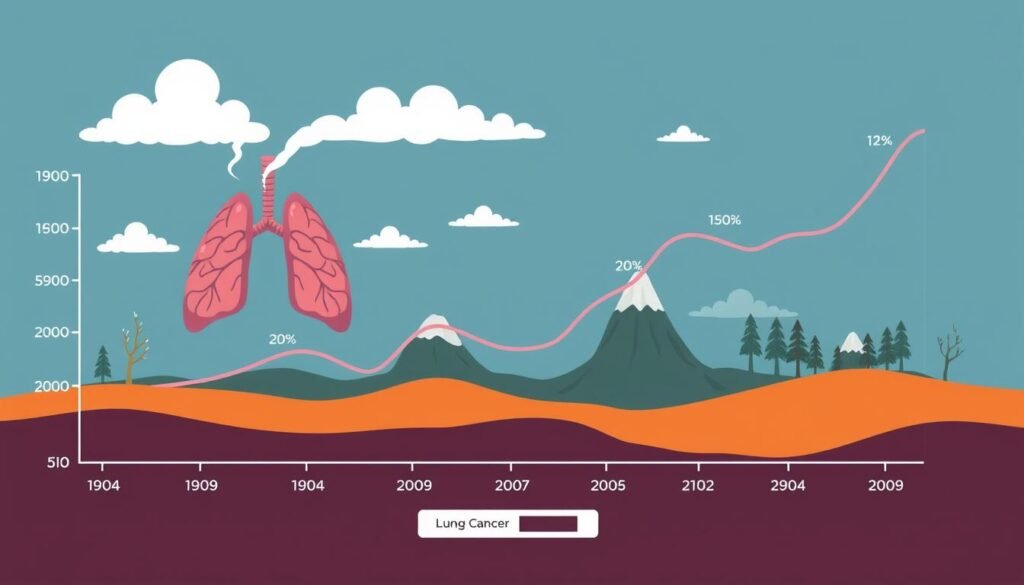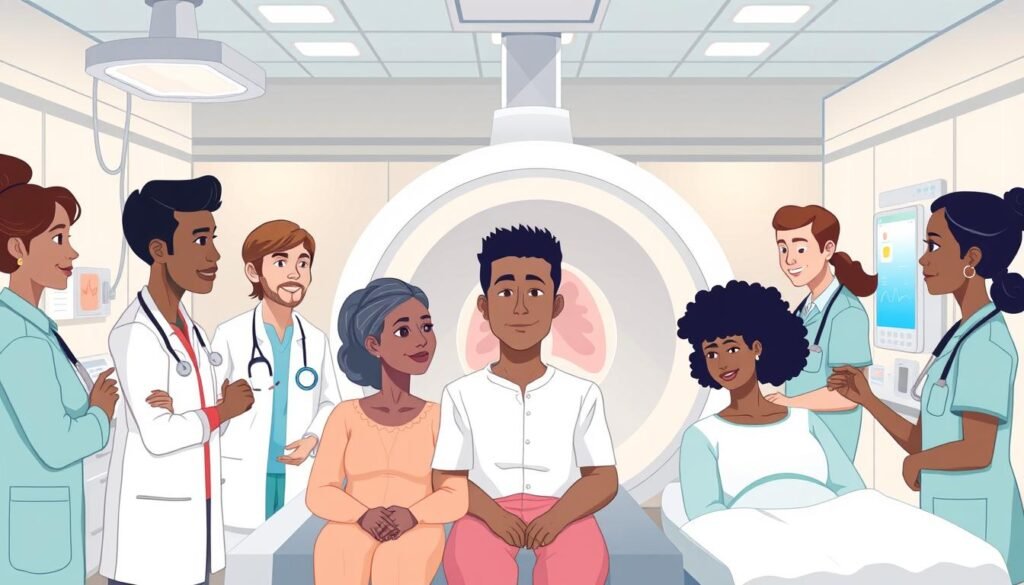Lung cancer causes more deaths than colon, breast, and prostate cancers put together. It takes about 125,070 lives every year in the United States. This huge number shows the urgent need to keep track of lung cancer statistics for 2024. It points out a big public health crisis. 2024 will see nearly 234,580 new cases of lung and bronchus cancer. This indicates an ongoing struggle within the area of lung cancer research. These numbers show how serious this illness is. They remind us of the tough reality of cancer incidences and death rates.
Even though smoking is a key risk factor, it’s surprising that nearly 20% of those who get lung cancer don’t smoke. This fact shows how complex lung cancer is. It’s very important to understand how often it occurs and how deadly it is. This knowledge helps create better ways to prevent and treat it. Right now, the five-year survival rate is about 28%. This fact stresses the importance of finding the disease early and making healthcare better.
Key Takeaways
- Approximately 234,580 new lung cancer cases are expected in the U.S. for 2024.
- Lung cancer is the leading cause of cancer deaths, accounting for about 20.4% of all cancer-related fatalities.
- The five-year relative survival rate for lung cancer patients stands at 28%.
- Only 4.5% of high-risk individuals are being screened for lung cancer.
- Nearly 1 in 16 men and 1 in 17 women will be diagnosed with lung cancer in their lifetime.
- The incidence of new lung cancer diagnoses has been declining steadily since 2006.
- Black men are approximately 12% more likely to develop lung cancer than White men.
Overview of Lung Cancer in the United States
Lung cancer is the top cancer type in the U.S., ranking third in how often it occurs. It mainly affects older people, with most cases found in those 65 and older. Smoking is the biggest risk for lung cancer.
According to statistics, 234,580 new lung cancer cases are expected in 2024. This will be about 11.7% of all new U.S. cancer cases. Also, lung cancer will likely cause 125,070 deaths, which is 20.4% of all cancer deaths.
Not everyone is affected by lung cancer the same way. Some groups, like Black men, have more cases than White men. Rates can differ due to gender, race, and money matters.
There’s been progress in lung cancer treatment and finding it early. This has helped lower how many people get and die from lung cancer. But, only 16% of people at high risk got screened in 2022.
With a survival rate of 28.4% after five years, it’s crucial to keep improving our fight against lung cancer. The situation is challenging but changing, showing some hope.
Current Statistics on the Incidence and Mortality of Lung Cancer
Lung cancer poses a serious public health issue today. By 2024, an estimated 234,580 new cases are expected. These cases are nearly split between men, with 116,310, and women, with 118,270. About 125,070 people might lose their lives to lung cancer in 2024. This includes 65,790 men and 59,280 women.
Estimated New Cases and Deaths in 2024
Lung cancer has a significant impact on health. The upcoming new cases and death rates show the battle we face. It’s a reminder that lung cancer is a big challenge that needs urgent action and better prevention and treatment plans.
Lung Cancer as a Leading Cause of Cancer Deaths
Lung cancer leads in causing cancer deaths in the U.S. for both men and women. It’s behind nearly 1 in 5 cancer deaths. The death rate adjusted for age is 32.4 per 100,000 people. Only about 26.7% of those diagnosed survive past five years. This highlights the urgent need for better screening and treatments against lung cancer.
Lung Cancer Rates by Demographics
Understanding lung cancer means looking into its demographics. Diving into age, gender, and ethnicity reveals important patterns. Each factor shows how widespread and complex lung cancer is.
Incidence Rates Among Different Age Groups
Lung cancer mostly affects older adults, especially those over 65. The average person is diagnosed around 70 years old. This shows lung cancer is more common as people age.
Under 45, lung cancer is rare. Age-based data stresses the need for awareness and prevention in older folks.
Gender-Based Statistics
Men are more likely to get lung cancer than women. For men, the risk is 1 in 16; for women, it’s 1 in 17. Although rates are down for both, men still have higher death rates.
Death rates from lung cancer are 37% higher in men than in women. This highlights the need for health strategies that address these differences.
Racial and Ethnic Disparities
Lung cancer affects ethnic groups differently. Black men, for instance, have a higher risk than White men. However, Black women have lower rates than their White counterparts.
These variations show we need better healthcare access and interventions for those most affected. It points to a need for equity in health strategies.
| Group | Incidence Rate (per 100,000) |
|---|---|
| Black Males | 68.3 |
| White Males | 61.5 |
| Black Females | 44.0 |
| White Females | 52.7 |
| Asian/Pacific Islander Males | Lower Rates |
| Latino Males | Lowest Rates |
Lung Cancer Prevalence and Trends Over the Years
The history of lung cancer has changed a lot due to societal shifts and health moves. Learning about these changes helps us see how future prevention could impact illness and death rates.
Historical Context of Lung Cancer Statistics
Lung cancer’s statistical history tells us about its rising dangers. A major factor was the high smoking rates last century. Because of this, lung cancer cases went up.
In the last 30 years, lung cancer rates slightly fell each year. But, its presence among people showed a small rise. This shows us both sides: more cases are found, but efforts to reduce it are working.
Recent Trends in Incidence and Mortality Rates
Recently, we have seen new patterns in lung cancer rates. From 2012 to 2021, there was a 2% yearly drop in new cases. Deaths from lung cancer also went down by 4.1% from 2013 to 2022. These changes show the success of better awareness and fighting smoking.
In 2020, over two million people faced new lung cancer cases worldwide, and 1.8 million died. Men were more affected than women. These recent figures give us hope for better handling and results in fighting lung cancer.

Impact of Smoking on Lung Cancer Statistics
Smoking has a strong link to lung cancer, which is a major concern for both research and public health. It’s found that 80-90% of lung cancer cases in the U.S. are due to smoking. This fact underlines how crucial it is to understand these statistics to prevent more cases.
Prevalence of Smoking-Related Lung Cancer
Smokers are much more likely than non-smokers to get lung cancer. The risk is 15 to 30 times higher. For current smokers, men have a 14.8% chance of getting lung cancer, women 11.2%. But quitting smoking can greatly reduce this risk and even add years to your life.
Statistics on Non-Smoking Lung Cancer Cases
Though smoking leads the causes for lung cancer, non-smokers still get it too. About 10-20% of lung cancer cases are in people who’ve never smoked. Causes for non-smokers include genetics, radon, and workplace hazards. It’s important to know about these risks, not just the smoking ones.
| Smoking Status | Lifetime Risk of Lung Cancer |
|---|---|
| Never Smoker (Males) | 1.8% |
| Former Smokers (Males) | 7.2% |
| Current Smokers (Males) | 14.8% |
| Never Smoker (Females) | 1.3% |
| Former Smokers (Females) | 5.8% |
| Current Smokers (Females) | 11.2% |
Lung Cancer Survival Rates and Prognosis
Learning about lung cancer survival rates helps us understand its prognosis and treatment success. Currently, the five-year survival rate is at 26.7%. To lift this number, early detection and treatment are key.
Five-Year Relative Survival Rates
The survival rates for non-small-cell lung cancer (NSCLC) differ greatly, depending on the cancer stage at diagnosis:
| Stage | 5-Year Survival Rate |
|---|---|
| Localized | 60% |
| Regional | 33% |
| Distant | 6% |
| All Stages | 23% |
Small-cell lung cancer (SCLC) shows a distinct outlook:
| Stage | 5-Year Survival Rate |
|---|---|
| Localized | 29% |
| Regional | 15% |
| Distant | 3% |
| All Stages | 6% |
These numbers highlight how crucial early detection is for improving survival in lung cancer. Sadly, over 40% are diagnosed at the distant stage, drastically lowering survival rates.
Survival Rates by Stage at Diagnosis
The stage of lung cancer at diagnosis greatly impacts survival rates. These rates use the TNM staging system to show how each stage affects survival:
| Stage | 2-Year Survival Rate | 5-Year Survival Rate |
|---|---|---|
| IA1 | 97% | 90% |
| IA2 | 94% | 85% |
| IA3 | 92% | 80% |
| IB | 89% | 73% |
| IIA | 82% | 65% |
| IIB | 76% | 56% |
| IIIA | 65% | 41% |
| IIIB | 47% | 24% |
| IIIC | 30% | 12% |
| IVA | 23% | 10% |
| IVB | 10% | 0% |
Survival rates fall dramatically as lung cancer progresses. It highlights the vital importance of detecting it early. The American Cancer Society provides detailed survival rates, showing how crucial awareness and screening are. For more details, visit lung cancer survival statistics.
Risk Factors Associated with Lung Cancer
Learning about lung cancer risk factors is key for prevention. Many factors increase the risk of this serious disease. Knowing these causes helps people choose healthier lifestyles.
Common Risk Factors for Lung Cancer
Here are the main risks:
- Smoking – It’s the top cause, linked to about 80% of lung cancer deaths.
- Secondhand Smoke – Even non-smokers can get lung cancer if they’re around smoke.
- Radon Gas – This gas is the number two cause, especially in non-smokers.
- Asbestos Exposure – High-risk jobs in mines or shipyards increase lung cancer risks due to asbestos.
- Pollutants – Things like air pollution play a smaller role, involved in 1-2% of cases.
- Genetics – Family history means a higher risk.
Increased Risk Among Certain Populations
Some groups have a higher lung cancer risk:
- Age – Risk increases with age, especially for those who smoke.
- Gender – Men are more likely to get lung cancer than women.
- Ethnic Minorities – Black men have higher rates, pointing to the need for better health education.
| Risk Factor | Impact on Lung Cancer Risk |
|---|---|
| Smoking | 80% of lung cancer deaths |
| Secondhand Smoke | Significant contributor to lung cancer in non-smokers |
| Radon Gas | Second leading cause, especially non-smokers |
| Asbestos Exposure | Increased risk among workers in specific industries |
| Outdoor Air Pollution | Accounts for 1-2% of lung cancer deaths |
| Family History | Twice the likelihood of developing lung cancer |
Lung Cancer Screening and Early Detection
Screening for lung cancer is key in helping patients live longer. Finding the disease early by using Low-dose computed tomography (LDCT) scans can lower the chance of dying from lung cancer in people at high risk. Screening the right way means we can spot cancer sooner and treat it more effectively.
Importance of Lung Cancer Screening Programs
Lung cancer screening saves lives by catching the disease early. Using LDCT can cut the number of deaths from lung cancer by 20% compared to regular chest X-rays. This shows just how crucial early detection and screening are for healthier future results.
Guidelines for Screening and Early Detection
The U.S. Preventive Services Task Force suggests people 50 to 80 who smoked a lot get checked every year. They’re looking at those with a 30-pack-year smoking history, people who smoke now, or those who quit in the past 15 years. It’s very important these high-risk groups get screened early.

| Population | Age Group | Smoking History | Screening Recommendation |
|---|---|---|---|
| Adults | 50-80 | 30-pack-year | Annual LDCT |
| Current Smokers | Any | Any | Annual LDCT |
| Former Smokers | 50-80 | Quit within last 15 years | Annual LDCT |
Knowing and following these guidelines can greatly improve detecting cancer early on. It also greatly lowers the risk of dying from lung cancer.
Healthcare Disparities in Lung Cancer Management
Lung cancer healthcare disparities show clear differences in treatment and results among groups. These disparities come from socio-economic factors, where people live, and healthcare system differences. To improve health equity, understanding these disparities is key.
Access to Treatment Across Different Demographics
Access to cancer treatment differs widely across demographics, affecting survival rates significantly. Black males have a higher lung cancer rate at 73.5 per 100,000 compared to white males at 63.5. This highlights the need for specific actions to reduce these disparities.
There’s also a disparity in the age when people get lung cancer. Black individuals often get diagnosed at 67, younger than white individuals who get diagnosed at 70. This shows the need for timely treatments for certain groups. Hispanic people also struggle to access care on time despite smoking less.
Barriers to Effective Lung Cancer Care
Financial issues, lack of awareness, and differences in provider availability are major barriers. These factors prevent people from getting the best cancer treatments on time. Language and cultural differences also make patient-provider communication harder.
African Americans with lung cancer often smoke less compared to whites. But, they face unique challenges in getting care. This underlines the need for better support and outreach efforts.
Innovations in Lung Cancer Treatment and Research
Lung cancer treatment has grown a lot recently. New therapies are now available, thanks to this growth. They help patients live longer and feel better. Research keeps finding new ways to treat lung cancer.
Advancements in Treatment Options
There are now treatments focused on specific goals and boosting the immune system. For instance, finding mutations in the EGFR gene has led to better treatments. These advancements help patients a lot.
Ongoing Research and Future Directions
Scientists are working hard to understand lung cancer better. They use artificial intelligence to find new ways to diagnose and treat it. This work could change the future of lung cancer care.

| Innovation Type | Description | Impact on Patients |
|---|---|---|
| Targeted Therapies | For specific genetic mutations, providing personalized treatment options. | Increased response rates and survival for mutation-positive patients. |
| Immunotherapy | Harnesses the body’s immune system to target cancer cells. | Extended survival rates and improved quality of life. |
| Enhanced Screening | Utilization of advanced imaging techniques for early detection. | Early diagnosis leading to more effective treatment options. |
| Biomarker Testing | Identifies the most effective therapies based on individual genetic profiles. | Increased precision in treatment selection. |
Advancements in treating lung cancer look hopeful. But, research must continue to make things even better. Knowing more about lung cancer on a molecular level can guide us to new treatments. This could mean a brighter future for people with lung cancer.
Conclusion
Lung cancer is a big public health issue in the US, with troubling figures that show its effect. About 235,760 new cases were found in 2021, leading to 131,880 deaths. This was 22% of all cancer deaths. These numbers show why it’s vital to keep working on prevention, finding it early, and better treatments.
The number of lung cancer cases and deaths has gone down over the years. But, not everyone has seen this improvement. Black men, for example, have a higher rate of lung cancer than White men. We need to fix these health care gaps to help everyone. Also, not enough people are getting screened for lung cancer. Raising awareness about the dangers and early screening can save lives.
To make progress against lung cancer, we must focus on new research, better treatments, and wide-reaching health programs. This focus can hugely improve patient outcomes and lessen lung cancer’s impact. Our efforts today can bring more hopeful results in the future. We could see a future where the lung cancer conclusion is filled with hope and improvement.